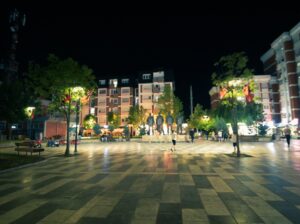Abandoned Mansion

Many once-opulent houses have been abandoned across the world. The buildings are in poor condition, with shattered windows, missing roofs, and disintegrating masonry.
Some have become squatter and animal colonies.
5 Mudhouse Road
One of these once-grand mansions formerly stood on Mudhouse Road in Lancaster, Ohio. Abraham Kagy and Henry Byler originally owned the land, which they sold to Christian and Eleanor Rugh. The structure was built in 1875. In 1919, Henry and Martha Hartman purchased it once more. Lulu Hartman Mast acquired the house after her father died in 1930, and it is still owned by the Mast family today.
Locals have labeled the house as haunted, as they do with most abandoned residences. For many years, stories of mass murder, child murder, and other atrocities have circulated.
Since the 1930s, no one has resided in the house, and the owners have aggressively guarded it, filing charges against anybody caught trespassing. The mansion may have been salvageable until a fire damaged the roof and some of the interior, but the Mast family refused to sell. They further stated that restoring the house to habitable condition and to conventional regulations would cost millions of dollars. The residence had only intermittent power and no plumbing.
The structure was dismantled in September 2015. Locals gathered down the road to see the demolition of the ancient home. The demolition firm sought to rescue as much as possible, and many of these artifacts are now for sale on amethystandivy.com/mudhouse-mansion with the family’s consent.
4 Cambusnethan House
Another derelict home remains forlornly empty in North Lanarkshire, Scotland. James Gillespie Graham designed it, and it was finished in 1820. Cambusnethan House, also known as Cambusnethan Priory, was built to replace a Norman-age tower and manor house that had been destroyed by fire in 1816.
The old residence was surrounded by apple orchards, and it is said that in the mid-1700s, Mr. Paton, a gardener at Cambusnethan House, produced a new apple variety named the Cambusnethan Pippin.

The Lockhart family owned the property, which had been in use until 1984, when another fire destroyed the inside. The Scottish Civic Trust has designated the site as “At Risk,” and an organization called Friends of Cambusnethan Priory was formed in March 2014 to gather funding to rescue this historic monument. At www.cambusnethanpriory.com, donations can be made and memories shared.
3 Miranda Castle
Miranda Castle in Belgium was built in 1866 by the Liedekerke-De Beaufort family. The architect was an Englishman called Edward Milner, who sadly died before the house was finished.
According to legend, the structure was constructed in 1903 by a French architect called Pelchner. During the French Revolution, the Liedekerke-De Beaufort family was compelled to evacuate France and settle in Belgium.

The family stayed in the house until World War II, when they were forced to evacuate when Nazi army authorities took over the structure and put them in the firing line during the Battle of the Bulge. The National Railway Company of Belgium took over the property in 1950 and used it to accommodate orphans and chronically ill children until the late 1970s. The home was lovingly nicknamed “Château de Noisy” by the residents at the time. The castle was abandoned in 1991 owing to the prohibitive expense of maintenance. It, like the previous properties, has been the victim of vandalism and fires.
The town of Celles has expressed interest in purchasing the land, but the owners have once again refused to sell. In 2013, the family requested for a permission to destroy the property but as of January 2106 the dilapidated structure was still standing and a petition is being distributed on www.change.org to rescue it from demolition.
2 The Liu Family Mansion of Taiwan

The Lin Ben Yuan family of Banqiao, Taiwan, commissioned the Three-Courtyard Mansion in 1929 to serve as a family dwelling. The family utilized the previously majestic property as their headquarters as leaders of the Zhangzhou immigrants until the Japanese colonization of Taiwan ended in the 1950s.
There are various ghost stories, including one about a family servant who committed suicide and another about Japanese Imperial soldiers who inhabited the building during the Japanese occupation and were killed out during a fight on the grounds. Nearby trees have started to ring the hollow, abandoned mansion with roots and branches, attempting to recover the ground and turn it back into jungle. Explorers have been visiting the region for so long that one astute business owner has erected a coffee shop next door named the Haunted Café to capitalize on the tourist traffic. The historic home will not be demolished, and the property owners appear to encourage explorers and tourists.
1 The Tyrone House

yrone House in County Galway, Ireland, was planned in the Palladian style by John Roberts of Waterford and erected in 1779 for Christopher St. George, whose family controlled a vast tract of land in Kilcolgan in the 17th and 18th centuries. Originally, the entry hall had a life-size white marble statue of the second Lord St. George costumed as a Roman emperor and placed beneath the St. George family insignia.
The Tyrone home represented classical Irish style, surrounded by fruit orchards, rose gardens, wine vines, and a wildlife sanctuary. St. Georges was also a horse breeder and the originator of the Galway Races. The St. George family eventually departed the house after emptying away the treasures, which were split among family members.
The manor house had already begun to deteriorate by 1912. During the Irish War of Independence in the 1920s, the Irish Republican Army demolished the interior to prevent the Royal Irish Constabulary Special Reserve from using it as a hospital. According to legend, the old caretaker, who was sick and unable to evacuate, was carried to an outbuilding used as an office before the building was destroyed, along with his bedroom furnishings and beddingfurniture.





